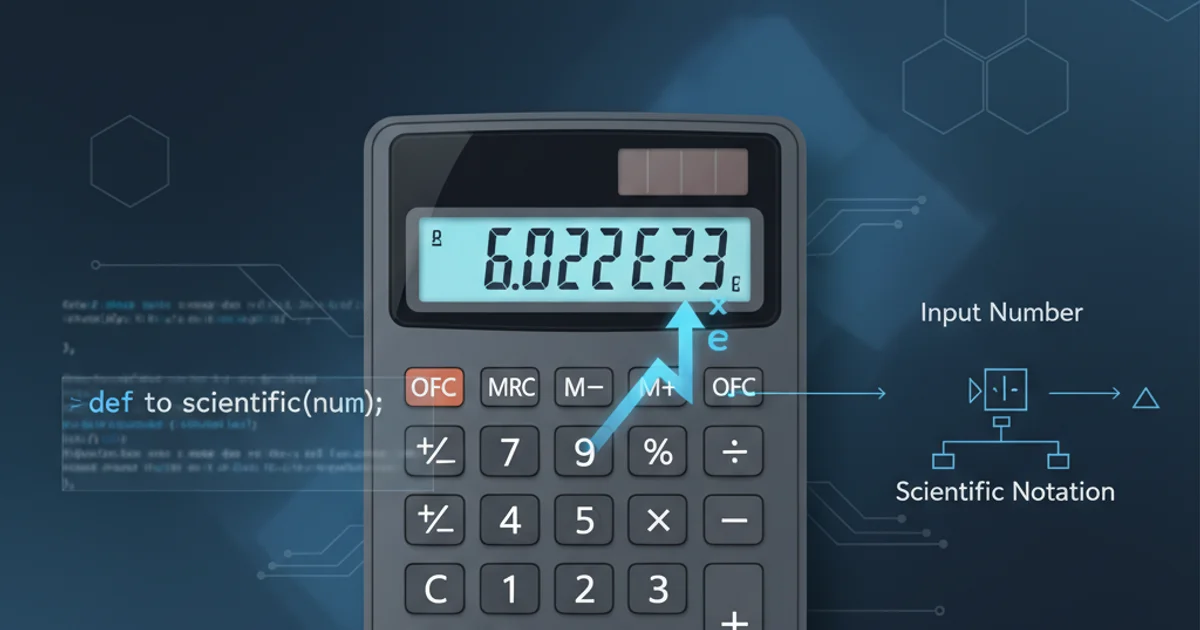How can I convert numbers into scientific notation?
Categories:
Converting Numbers to Scientific Notation in JavaScript

Learn how to effectively convert numbers into scientific notation using JavaScript's built-in methods, ensuring precision and readability for large or small values.
Scientific notation is a way of expressing numbers that are too large or too small to be conveniently written in decimal form. It is commonly used in science, engineering, and mathematics. In JavaScript, converting numbers to scientific notation is straightforward, primarily utilizing the toExponential() method. This article will guide you through the process, explain its nuances, and provide practical examples.
Understanding Scientific Notation
Scientific notation represents a number as a product of two parts: a coefficient and a power of 10. The coefficient is typically a number between 1 and 10 (inclusive of 1, exclusive of 10), and the power of 10 indicates how many places the decimal point has been moved. For example, 123,000 can be written as 1.23 x 10^5, and 0.000045 can be written as 4.5 x 10^-5. This format simplifies calculations and improves readability for extreme values.
flowchart TD
A[Original Number] --> B{Is it very large or very small?}
B -- Yes --> C[Convert to Scientific Notation]
C --> D{Coefficient (1 <= N < 10)}
C --> E[Power of 10]
D & E --> F["Result: Coefficient x 10^Power"]
B -- No --> G[Keep as Decimal]
F & G --> H[End]Flowchart illustrating the decision process for using scientific notation.
Using toExponential() for Conversion
JavaScript's Number.prototype.toExponential() method is the primary tool for converting a number into scientific notation. It returns a string representation of the number in exponential form. You can optionally specify the number of digits after the decimal point in the coefficient.
const largeNumber = 123456789;
const smallNumber = 0.000000123;
const zero = 0;
console.log(largeNumber.toExponential()); // "1.23456789e+8"
console.log(smallNumber.toExponential()); // "1.23e-7"
console.log(zero.toExponential()); // "0e+0"
// With specified precision
console.log(largeNumber.toExponential(2)); // "1.23e+8"
console.log(smallNumber.toExponential(1)); // "1.2e-7"
console.log((123.456).toExponential(4)); // "1.2346e+2"
Examples of toExponential() with and without precision.
toExponential() method returns a string. If you need to perform further mathematical operations, you'll need to convert it back to a number using parseFloat() or the unary plus operator +.Handling Edge Cases and Precision
When working with toExponential(), it's important to consider how precision affects the output. The argument passed to toExponential() specifies the number of digits after the decimal point in the coefficient. If omitted, JavaScript determines the necessary precision to represent the number accurately. Be mindful that excessive precision can lead to long strings, while too little can result in loss of information.
const num = 9876543210;
console.log(num.toExponential()); // "9.87654321e+9" (default precision)
console.log(num.toExponential(0)); // "1e+10" (rounds up, no decimal digits)
console.log(num.toExponential(3)); // "9.877e+9" (rounds to 3 decimal digits)
const verySmall = 0.00000000000000012345;
console.log(verySmall.toExponential(2)); // "1.23e-16"
console.log(verySmall.toExponential(5)); // "1.23450e-16" (pads with zeros)
Demonstrating precision control and rounding with toExponential().
toExponential(0) as it can lead to significant rounding, potentially misrepresenting the original number if not handled carefully.1. Define Your Number
Start by defining the number you wish to convert. This can be any numeric value, positive or negative, integer or float.
2. Call toExponential()
Invoke the toExponential() method on your number. You can pass an optional argument for the desired number of digits after the decimal point.
3. Handle the Result
The method returns a string. If you need to use the number for further calculations, convert it back to a numeric type using parseFloat().